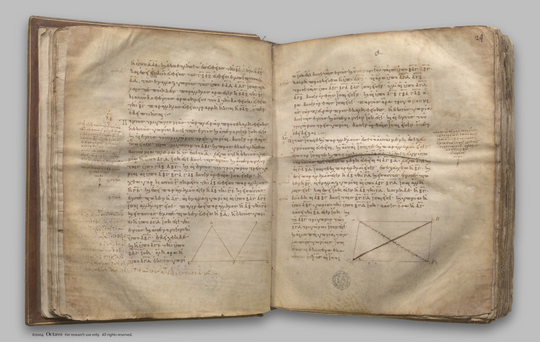index prev next | digilib folio 28

The straight lines joining equal and parallel straight lines (at the extremities which are) in the same directions (respectively) are themselves also equal and parallel.
| Αἱ τὰς ἴσας τε καὶ παραλλήλους ἐπὶ τὰ αὐτὰ μέρη ἐπιζευγνύουσαι εὐθεῖαι καὶ αὐταὶ ἴσαι τε καὶ παράλληλοί εἰσιν. Ἔστωσαν ἴσαι τε καὶ παράλληλοι αἱ ΑΒ, ΓΔ, καὶ ἐπιζευγνύτωσαν αὐτὰς ἐπὶ τὰ αὐτὰ μέρη εὐθεῖαι αἱ ΑΓ, ΒΔ: λέγω, ὅτι καὶ αἱ ΑΓ, ΒΔ ἴσαι τε καὶ παράλληλοί εἰσιν. Ἐπεζεύχθω ἡ ΒΓ. καὶ ἐπεὶ παράλληλός ἐστιν ἡ ΑΒ τῇ ΓΔ, καὶ εἰς αὐτὰς ἐμπέπτωκεν ἡ ΒΓ, αἱ ἐναλλὰξ γωνίαι αἱ ὑπὸ ΑΒΓ, ΒΓΔ ἴσαι ἀλλήλαις εἰσίν. καὶ ἐπεὶ ἴση ἐστὶν ἡ ΑΒ τῇ ΓΔ κοινὴ δὲ ἡ ΒΓ, δύο δὴ αἱ ΑΒ, ΒΓ δύο ταῖς ΒΓ, ΓΔ ἴσαι εἰσίν: καὶ γωνία ἡ ὑπὸ ΑΒΓ γωνίᾳ τῇ ὑπὸ ΒΓΔ ἴση: βάσις ἄρα ἡ ΑΓ βάσει τῇ ΒΔ ἐστιν ἴση, καὶ τὸ ΑΒΓ τρίγωνον τῷ ΒΓΔ τριγώνῳ ἴσον ἐστίν, καὶ αἱ λοιπαὶ γωνίαι ταῖς λοιπαῖς γωνίαις ἴσαι ἔσονται ἑκατέρα ἑκατέρᾳ, ὑφ' ἃς αἱ ἴσαι πλευραὶ ὑποτείνουσιν: ἴση ἄρα ἡ ὑπὸ ΑΓΒ γωνία τῇ ὑπὸ ΓΒΔ. καὶ ἐπεὶ εἰς δύο εὐθείας τὰς ΑΓ, ΒΔ εὐθεῖα ἐμπίπτουσα ἡ ΒΓ τὰς ἐναλλὰξ γωνίας ἴσας ἀλλήλαις πεποίηκεν, παράλληλος ἄρα ἐστὶν ἡ ΑΓ τῇ ΒΔ. ἐδείχθη δὲ αὐτῇ καὶ ἴση. Αἱ ἄρα τὰς ἴσας τε καὶ παραλλήλους ἐπὶ τὰ αὐτὰ μέρη ἐπιζευγνύουσαι εὐθεῖαι καὶ αὐταὶ ἴσαι τε καὶ παράλληλοί εἰσιν: ὅπερ ἔδει δεῖξαι. | The straight lines joining equal and parallel straight lines (at the extremities which are) in the same directions (respectively) are themselves also equal and parallel. Let AB, CD be equal and parallel, and let the straight lines AC, BD join them (at the extremities which are) in the same directions (respectively); I say that AC, BD are also equal and parallel. Let BC be joined. Then, since AB is parallel to CD, and BC has fallen upon them, the alternate angles ABC, BCD are equal to one another. [I. 29] And, since AB is equal to CD, and BC is common, the two sides AB, BC are equal to the two sides DC, CB; and the angle ABC is equal to the angle BCD; therefore the base AC is equal to the base BD, and the griangle ABC is equal to the triangle DCB, and the remaining angles will be equal to the remaining angles respectively, namely those which the equal sides subtend; [I. 4] therefore the angle ACB is equal to the angle CBD. And, since the straight line BC falling on the two straight lines AC, BD has made the alternate angles equal to one another, AC is parallel to BD. [I. 27] And it was also proved equal to it. Therefore etc. |